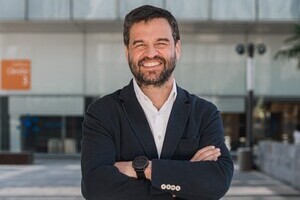Telefonica Tech to deploy 130,000 smart meters for Canal de Isabel II

Gonzalo Martin-Villa of Telefonica Tech
Madrid, 28 December 2021 – Telefonica Tech, , Telefonica’s digital business unit, and Contazara, Spain’s manufacturer of electronic meters, will deploy 130,000 smart meters for the public utility. This first phase is the start of Canal de Isabel II’s planned total mass roll-out plan, which will see it install approximately 650,000 water meters with integrated Narrow Band IoT (NBIoT) communication over the next three years.
This type of meter allows remote reading of user consumption data, collecting them remotely and automatically. These devices have NBIoT connectivity, which enables greater reach and penetration of the coverage, for places such as basements, manholes or meter rooms.
Once the data reaches the management platforms, analytical models are created through Artificial Intelligence that enable predictive maintenance, which leads, among other benefits, to improved efficiency in water supply, early detection of leaks in networks, control of unauthorised consumption or identification of low consumption in at-risk groups to alert social services of possible critical situations.
The objective of Canal de Isabel II is to optimise the water supply service, protecting the water resource against inefficient consumption, and to offer a better service to its customers. Users will go from a bimonthly reading to an hourly reading, which will provide them with more information, giving them a much deeper and more accurate knowledge of their consumption. In this way, they will be able to monitor possible anomalous consumption in much greater detail and will have at their disposal comparative consumption patterns and even personalised savings models.
Telefonica Tech and Contazara are technological partners that collaborate and develop NBIoT technology for the control and correct management of water, as well as being in charge of the supply and communications service for Canal de Isabel II.

Pascual Fernandez
According to Pascual Fernandez, CEO of Canal de Isabel II, “Canal de Isabel II’s Smart Region Plan strengthens the leadership of our public company and allows us to advance in two essential lines of our company, proximity to users, offering them more and better services and information, and sustainability, helping us to increase efficiency in the management and exploitation of our most important resource, water”.
Gonzalo Martin-Villa, CEO of IoT & big data at Telefonica Tech, says, “We are very proud that Telefonica Empresas has been awarded this project for Canal de Isabel II, making us their technology partner in this transformation they are carrying out. With this agreement we consolidate our position as leaders in providing NBIoT connectivity solutions, guaranteeing an open, comprehensive, scalable and secure solution with devices that make it possible and that have been fully tested in our TheThinx laboratory”.
Isaac Navarro, CEO of Contazara, says, “This project represents the consolidation of the strategy of mass deployment of smart water meters with NBIoT communication in Spain, the two most advanced and reliable technologies in the world, positioning Canal de Isabel II, Contazara and Telefonica Tech at the global forefront of digital and sustainable water management”.
Focusing on sustainability and efficiency
According to data provided by Telefonica Tech, the application of IoT technology in water telemetry could reduce water leaks by 40% with smart metering systems, reduce operation and maintenance costs by 20% and improve customer satisfaction rates by up to 60%.
In addition to savings in water consumption, maintenance, by becoming remote and centralised, avoids trips to the physical location of the meters, which has an impact both on the bottom line and on the reduction of the carbon footprint.
In addition, NB-IoT-connected telereading devices have been developed with batteries that optimise their power consumption and last up to twelve years, thus reducing the energy consumed and extending the device’s lifetime by years.
Comment on this article below or via Twitter @IoTGN
